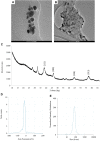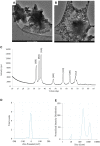Biofabrication of novel silver and zinc oxide nanoparticles from Fusarium solani IOR 825 and their potential application in agriculture as biocontrol agents of phytopathogens, and seed germination and seedling growth promoters
- PMID: 37601908
- PMCID: PMC10436318
- DOI: 10.3389/fchem.2023.1235437
Biofabrication of novel silver and zinc oxide nanoparticles from Fusarium solani IOR 825 and their potential application in agriculture as biocontrol agents of phytopathogens, and seed germination and seedling growth promoters
Abstract
Introduction: Plant pathogenic microorganisms adversely affect the growth and yield of crops, which consequently leads to losses in food production. Metal-based nanoparticles (MNPs) can be a remedy to solve this problem. Methods: Novel silver nanoparticles (AgNPs) and zinc oxide nanoparticles (ZnONPs) were biosynthesized from Fusarium solani IOR 825 and characterized using Dynamic Light Scattering (DLS), Fourier Transform Infrared (FTIR) spectroscopy, Transmission Electron Microscopy (TEM), X-ray diffraction (XRD) and measurement of Zeta potential. Antibacterial activity of NPs was evaluated against four plant pathogenic strains by determination of the minimum inhibitory (MIC) and biocidal concentrations (MBC). Micro-broth dilution method and poisoned food technique were used to assess antifungal activity of NPs against a set of plant pathogens. Effect of nanopriming with both types of MNPs on maize seed germination and seedlings growth was evaluated at a concentration range of 1-256 μg mL-1. Results: Mycosynthesis of MNPs provided small (8.27 nm), spherical and stable (zeta potential of -17.08 mV) AgNPs with good crystallinity. Similarly, ZnONPs synthesized by using two different methods (ZnONPs(1) and ZnONPs(2)) were larger in size (117.79 and 175.12 nm, respectively) with Zeta potential at -9.39 and -21.81 mV, respectively. The FTIR spectra showed the functional groups (hydroxyl, amino, and carboxyl) of the capping molecules on the surface of MNPs. The values of MIC and MBC of AgNPs against bacteria ranged from 8 to 256 μg mL-1 and from 512 to 1024 μg mL-1, respectively. Both types of ZnONPs displayed antibacterial activity at 256-1024 μg mL-1 (MIC) and 512-2048 μg mL-1 (MBC), but in the concentration range tested, they revealed no activity against Pectobacterium carotovorum. Moreover, AgNPs and ZnONPs inhibited the mycelial growth of Alternaria alternata, Fusarium culmorum, Fusarium oxysporum, Phoma lingam, and Sclerotinia sclerotiorum. MIC and MFC values of AgNPs ranged from 16-128 and 16-2048 μg mL -1, respectively. ZnONPs showed antifungal activity with MIC and MFC values of 128-2048 μg mL-1 and 256-2048 μg mL-1, respectively. The AgNPs at a concentration of ≥32 μg mL-1 revealed sterilization effect on maize seeds while ZnONPs demonstrated stimulatory effect on seedlings growth at concentrations of ≥16 μg mL-1 by improving the fresh and dry biomass production by 24% and 18%-19%, respectively. Discussion: AgNPs and ZnONPs mycosynthesized from F. solani IOR 825 could be applied in agriculture to prevent the spread of pathogens. However, further toxicity assays should be performed before field evaluation. In view of the potential of ZnONPs to stimulate plant growth, they could be crucial in increasing crop production from the perspective of current food assurance problems.
Keywords: applied microbiology; biocontrol; biofabrication; biogenic nanoparticles; bionanotechnology; crop protection; mycosynthesis; plant pathogens.
Copyright © 2023 Trzcińska-Wencel, Wypij, Terzyk, Rai and Golińska.
Conflict of interest statement
The authors declare that the research was conducted in the absence of any commercial or financial relationships that could be construed as a potential conflict of interest.
Figures







Similar articles
-
Pre-sowing grain treatment with bio-AgNPs stimulates plant growth and affects redox homeostasis in maize.Front Plant Sci. 2025 May 22;16:1494741. doi: 10.3389/fpls.2025.1494741. eCollection 2025. Front Plant Sci. 2025. PMID: 40475907 Free PMC article.
-
Biogenic nanosilver bearing antimicrobial and antibiofilm activities and its potential for application in agriculture and industry.Front Microbiol. 2023 Feb 20;14:1125685. doi: 10.3389/fmicb.2023.1125685. eCollection 2023. Front Microbiol. 2023. PMID: 36891391 Free PMC article.
-
Biocidal Activity of Metal Nanoparticles Synthesized by Fusarium solani against Multidrug-Resistant Bacteria and Mycotoxigenic Fungi.J Microbiol Biotechnol. 2020 Feb 28;30(2):226-236. doi: 10.4014/jmb.1906.06070. J Microbiol Biotechnol. 2020. PMID: 31474084 Free PMC article.
-
Bioactive ZnO Nanoparticles: Biosynthesis, Characterization and Potential Antimicrobial Applications.Pharmaceutics. 2023 Nov 16;15(11):2634. doi: 10.3390/pharmaceutics15112634. Pharmaceutics. 2023. PMID: 38004613 Free PMC article. Review.
-
Tiny but mighty: metal nanoparticles as effective antimicrobial agents for plant pathogen control.World J Microbiol Biotechnol. 2024 Feb 19;40(3):104. doi: 10.1007/s11274-024-03911-5. World J Microbiol Biotechnol. 2024. PMID: 38372816 Review.
Cited by
-
Combat phytopathogenic bacteria employing Argirium-SUNCs: limits and perspectives.Appl Microbiol Biotechnol. 2024 Jun 1;108(1):357. doi: 10.1007/s00253-024-13189-0. Appl Microbiol Biotechnol. 2024. PMID: 38822872 Free PMC article. Review.
-
Identification and green synthesis of potato dry rot Fusarium falciforme silver nanoparticles, characterization and antibacterial activity.BMC Plant Biol. 2025 Aug 23;25(1):1120. doi: 10.1186/s12870-025-07124-2. BMC Plant Biol. 2025. PMID: 40847275 Free PMC article.
-
Pre-sowing grain treatment with bio-AgNPs stimulates plant growth and affects redox homeostasis in maize.Front Plant Sci. 2025 May 22;16:1494741. doi: 10.3389/fpls.2025.1494741. eCollection 2025. Front Plant Sci. 2025. PMID: 40475907 Free PMC article.
-
Antifungal Activity of ZnO Nanoparticles Synthesized from Eichhornia crassipes Extract for Construction Applications.Nanomaterials (Basel). 2024 Jun 11;14(12):1007. doi: 10.3390/nano14121007. Nanomaterials (Basel). 2024. PMID: 38921883 Free PMC article.
-
Mycosynthesis of zinc sulfide/zinc oxide nanocomposite using Fusarium oxysporum for catalytic degradation of methylene blue dye, antimicrobial, and anticancer activities.Sci Rep. 2024 Dec 31;14(1):32165. doi: 10.1038/s41598-024-81855-4. Sci Rep. 2024. PMID: 39741154 Free PMC article.
References
-
- Abd El-Aziz A. R. M., Al-Othman M. R., Mahmoud M. A., Metwaly H. A. (2015). Biosynthesis of silver nanoparticles using Fusarium solani and its impact on grain borne fungi. Dig. J. Nanomater. Biostructures 10, 655–662.
-
- Abdullah F. H., Bakar N. A., Bakar M. A. (2020). Low temperature biosynthesis of crystalline zinc oxide nanoparticles from Musa acuminata peel extract for visible-light degradation of methylene blue. Optik 206, 164279. 10.1016/j.ijleo.2020.164279 - DOI
-
- Abdul‐Baki A. A., Anderson J. D. (1973). Vigor determination in soybean seed by multiple criteria 1. Crop Sci. 13, 630–633. 10.2135/cropsci1973.0011183X001300060013x - DOI
LinkOut - more resources
Full Text Sources

